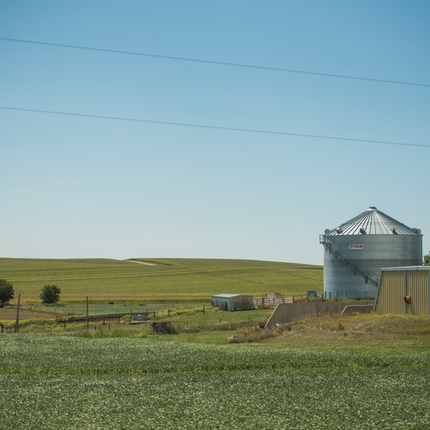By Kate Hansen, former staff member
There are a whole host of risks involved with farming and ranching; from weather conditions, to market changes, to all of the surprises that 2020 had in store. Managing risk has never been more important, and for many, crop insurance is a central risk management tool.
At the surface, crop insurance serves one purpose: reducing the financial risk of crop loss on an operation. However, in the long term, crop insurance options and availability also impact the viability of family farms, rural communities, and their resilience in uncertain times.
For years, the Center for Rural Affairs has advocated for crop insurance to be more accessible to operations of all shapes and sizes. Federal crop insurance is administered by the U.S. Department of Agriculture’s Risk Management Agency (RMA). We have encouraged RMA to make practical changes that would expand options for small family farms, veteran and beginning farmers and ranchers, diversified operations, organic operations, and more.
In recent months, RMA has announced some encouraging changes that we hope will increase access and utility of crop insurance for many.
APH change to increase crop insurance access for veteran and beginning farmers and ranchers
The yield or revenue a farmer insures with crop insurance is most often based on their Actual Production History (APH), or 4 to 10 years of their production history. Beginning farmers without established history must insure using county-level averages until they build up their own APH. However, county-level averages are typically lower than what a farmer would be able to insure with their own yields, so beginners often aren’t able to access the higher levels of coverage that established farmers use.
In early December, RMA announced a change that attempts to address this challenge. In the 2021 crop insurance year, beginning and veteran farmers and ranchers with previous farming experience will be allowed to use the Actual Production History (APH) of the land’s previous producer, with their permission.
Prior, this was available only if the farmer was previously involved with production on the land in question. Now, they are no longer required to be involved with previous production, so long as the former operator consents to their yield histories being used.
Changes made to Whole Farm Revenue Protection
Whole Farm Revenue Protection (WFRP) is an insurance program that offers revenue coverage for a wide range of crops, including otherwise uninsurable crops, and is often a good fit for diversified operations. Because it is a pilot program in its early years, changes can be made more easily to WFRP, and we have advocated for practical improvements in the program since its inception. Last year, RMA announced six changes to the program, a number of which were advocated for by the Center and our partners.
In August, RMA again made updates to the program, in particular a new commodity code option for producers who sell to direct markets. Commodity codes are generally assigned to specific crops. But under the new commodity code, farmers can insure revenue from direct market acres — acres whose production is sold directly to consumers — on which they grow two or more commodities.
Previously, each crop had to be reported under its own code. While it remains to be seen how this change will play out in practice, we are hopeful it will reduce laborious recordkeeping requirements for producers selling to direct markets, particularly those who have highly diversified operations.
WFRP differs from other forms of crop insurance because coverage is based on revenue as tracked in tax records. With the new commodity code, RMA will require a three year revenue history based on reported revenue from the combined direct market commodities.
ECO enhancement
In the 2021 crop insurance year, a new endorsement—Enhanced Coverage Option (ECO)—will be available. ECO offers coverage expansion up to 95%. An endorsement is essentially an add-on to a multi-peril policy, and ECO can be added to most Yield Protection and Revenue Protection policies.
Most federal Multi-Peril Crop Insurance (MPCI) is available at coverage levels between 50 to 85% of a farmer’s average expected yields or revenue. However, with ECO, coverage is available for 86%, 90% or 95% of expected yield or revenue. The endorsement pays losses on a local basis, and an indemnity payment is triggered when a county level yield or revenue drops below 90% or 95% of its expected level. There is an additional premium associated with this coverage.
The ECO endorsement will be available for 31 spring crops in 2021, including corn, soybeans, oats, wheat, buckwheat, popcorn, and dry peas, and RMA hopes to make it available for all additional crops starting in 2022.
Choosing a coverage level is a unique choice for each individual operation, and requires a farmer to evaluate the premium price, their long-term goals, and how much risk they are comfortable with taking on. This new endorsement is encouraging, as it provides more choice for family farms across the country, especially those who may not be in a position to take on a lot of risk.
Prevent plant change
If acres cannot be planted, most MPCI policies will cover a percentage of the original coverage guarantee. For corn and soybeans, that percentage is currently 55%and 60%, respectively.
RMA has now announced a number of changes to prevent planting coverage, including expanding the “1 in 4” requirement nationwide. Under this requirement producers must plant, insure, and harvest acreage in at least 1 of the 4 most recent crop years in order to be eligible for prevented planting coverage.
In 2012, this requirement was set in the Prairie Pothole region. The change will go into effect spring 2021.
In addition to these changes, RMA has also announced a number of flexibilities in response to the COVID-19 pandemic, such as extending the deadlines for organic certification and replant self-certification requirements.
The deadline to purchase crop insurance for most Midwest spring crops is March 15, 2021.





